Geese are one of the popular poultry birds that can be raised for meat and eggs. In fact, these large waterfowls’ popularity comes close to other domesticated birds such as chickens, ducks, and turkeys.
Although they are slightly larger than ducks but smaller than swans, geese can also be raised as pets. These birds’ history can be traced back as far as 3,000 years ago.
Back in ancient times, the Egyptians kept geese domestically, specifically Asia’s swan goose and Europe’s Graylag goose. During the Middle Ages, these birds were one of the important sources of food and fat. Even the Romans and Greeks put a religious significance toward a famous tale of white geese in the temples of Juno.
Fast forward to these modern days, geese still play a significant role in human lives. If you have the intention of raising these birds, then you’ve come to the right place. This article will serve as the ultimate guideline to raising geese, both for-profit and as family pets.
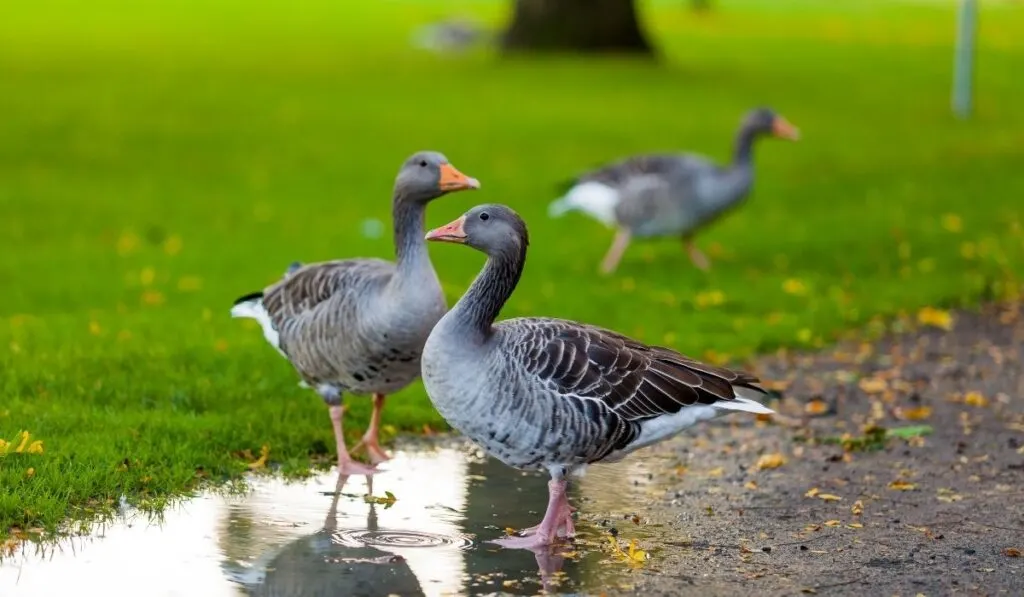
Finding the Best Goose Breed
Domestic geese come in different sizes, shapes, and colors. Depending on your goals and objectives of raising these birds, different breeds may serve different purposes. Before we dive into each breed that is available in the United States, we’re going to take a look at the origin of today’s domestic goose.
All domestic geese breeds descend from one of two wild geese: the European (Western) geese that descend from the Greylag goose, and Asian geese that descend from the swan goose.
The American Poultry Association (APA) has recognized a few standard breeds that can be raised domestically. These include:
| Breed | Weight in lbs. Male | Weight in lbs. Female | Foraging Ability | Temperament | No. of Eggs per Year |
| American Buff | 18 | 16 | Good | Docile | 25 – 35 |
| American Tufted Buff | 18 | 16 | Good | Calm | 35 – 50 |
| African | 18 | 16 | Excellent | Gentle | 35 – 45 |
| Chinese | 12 | 10 | Excellent | Calm | 30 – 50 |
| Embden | 25 | 20 | Good | Calm | 15 – 35 |
| Pilgrim | 14 | 12 | Excellent | Friendly | 20 – 45 |
| Pomeranian | 17 | 14 | Excellent | Changeable | 15 – 35 |
| Roman | 12 | 10 | Good | Docile | 25 – 35 |
| Sebastopol | 14 | 12 | Good | Changeable | 25 – 35 |
| Shetland | 10 | 7 | Excellent | Feisty | 15 – 30 |
| Toulouse | 20 | 18 | Good | Calm | 25 – 50 |
| Dewlap Toulouse | 26 | 20 | Good | Calm | 20 – 30 |
Most domestic goose breeds are raised for their meat. While some may produce both meat and eggs, there are also other breeds that can be raised for exhibition and ornamental purposes. When choosing a breed, it is important to look at their weight which could influence their purpose and function.
Goose breeds can be divided into three weight groups: heavy, medium, and light. Lightweight breeds may produce more eggs because the males can mate up to six females while males from heavy breeds mate with only two or three females.
On the other hand, heavy breeds can yield more meat and their carcasses weigh more than the lightweight geese. But most medium and heavyweight geese are considered good utility birds.
Aside from their physical and biological traits, you should also take into account their temperament and personality. If you want to raise geese as pets, then a friendlier and easy-going breed would be the best choice. But most breeders who are looking to grow geese on a large scale know that these birds won’t come into contact with humans very often. So, they won’t put too much focus on the temperament.
Finally, geese can also be raised for weed management and as guard animals.
Chinese geese are the most suitable breed to be raised as biological weeders. They are excellent foragers and their diet mainly consists of grasses and herbaceous plants.
Breeds such as Saddleback, Pomenarian, Tufted Roman, and Chinese are suited to be raised as guard animals. These birds usually make noises that are distinctive and much louder than other breeds.
Purchasing and Raising Goslings
For experienced breeders, there are no strict rules as to how large your flock of geese should be. But for beginners, it is always better to start with at least a pair of geese.
Buying adult geese is much easier than raising goslings, but hand-raised young birds will be more likely to form a strong bond with their owners.
When purchasing goslings, they need to be placed in a brooder with a surrounding temperature of 90°F during their first week. Then you can reduce the temperature by 5°F for the subsequent weeks until it reaches 70°F.
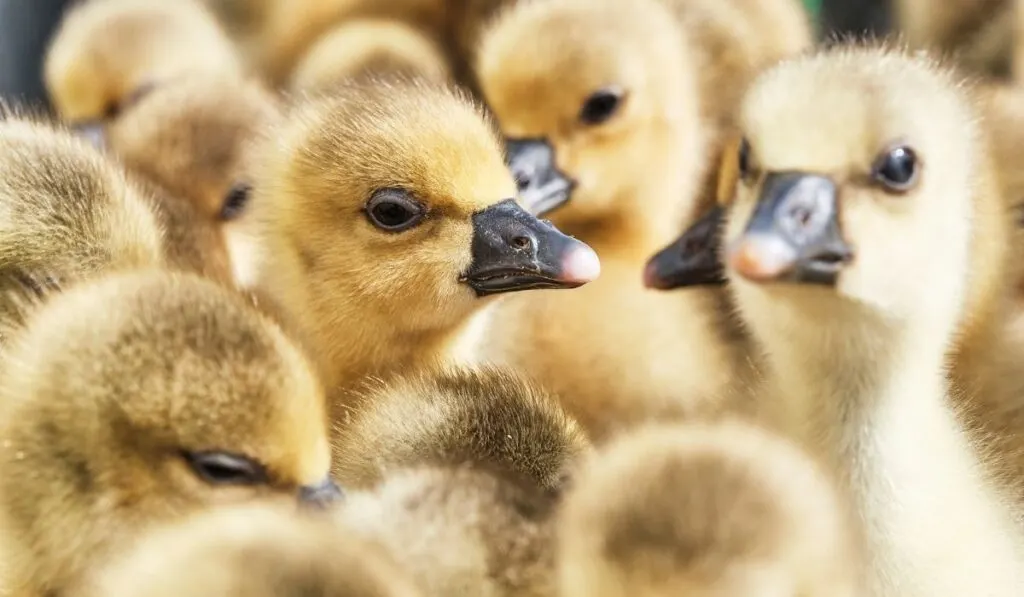
By six weeks, most goslings are fully grown and they can be released into a shelter or out on the range. The best time to purchase and raise goslings is in the early summer or late spring. The weather is warmer, drier, and favorable for these young birds to grow without too much assistance.
Setting up a brooder for goslings is fairly easy. You can use a dog crate or well-ventilated box with a heat lamp that serves to warm them at night or during cold days.
The brooder space should be at least half a square foot per bird and by two weeks, you can increase the space to 1 square foot. You should also use non-slippery mats or floorings to avoid your goslings from growing up with spraddle legs when they frequently slip on a smooth surface.
Geese tend to nurture and take care of their young very well. When you begin to breed your own geese, they should be paired at least one month before breeding season. Males generally will mate with the same females each year.
But there is no harm in having two or three females to avoid unwanted issues such as death or sickness that will inhibit their mating process. Females typically lay eggs in the early spring or late winter with an incubation period of around 30 days.
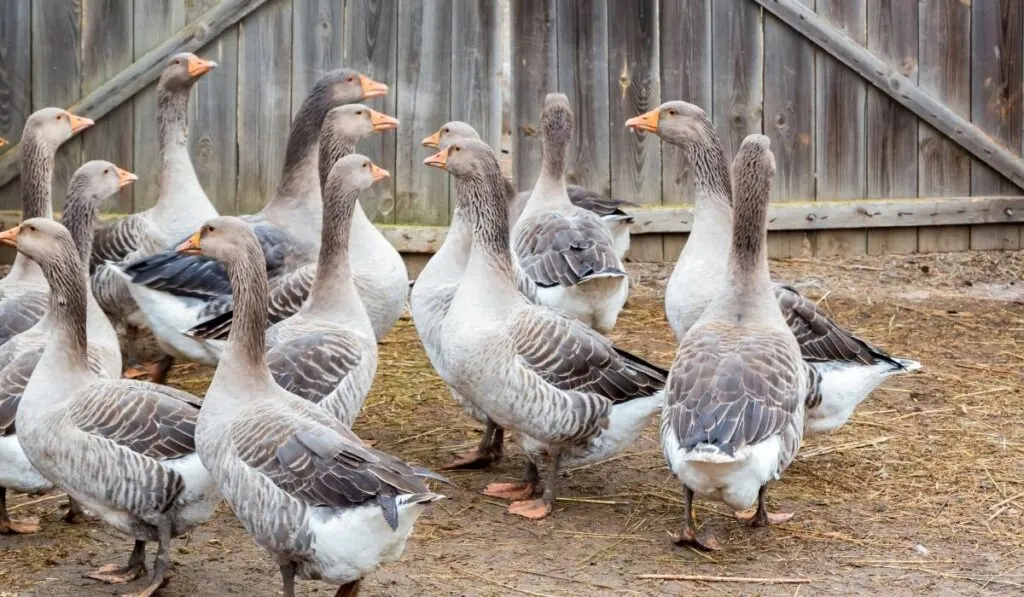
Building Shelters For Geese
Like many poultry birds, geese need proper housing to protect them from the elements and changing weather. Aside from a large roaming space, an indoor shelter will ensure that they have a proper place to sleep at night and lay eggs.
You can build a barn, shed, or any type of enclosed structure that is strong, weather-resistant, and properly ventilated. Each goose will need around 2 to 3 square feet of space.
The housing should be built near or on ground level. This is because geese are less nimble and will most likely have trouble jumping or walking on steep surfaces. At the entrance, you should also build a wide, sturdy wooden ramp that provides enough traction and prevents slipping.
The flooring is another thing to focus on when building safe housing. The larger breeds will need more traction to walk compared to lightweight breeds.
Some of the common types of floorings that you can use are concrete, dirt, and wooden floors. You can use concrete flooring that will provide enough protection from predators. However, this type of flooring must be covered with anti-slip mats or rubbery materials to provide enough grip and traction for the birds.

Wooden floors will provide enough traction for a certain period of time until they rot and warp, causing more maintenance over a long period of time. If you’re using dirt floors, you must also install additional structures that will protect the housing and your geese from predators.
You can build concrete trenches to deter digging predators or fences that won’t allow any large predators to enter the area. No matter which type of flooring you choose, make sure that it aligns with the overall structure of the shelter.
Aside from flooring, you should provide nesting boxes and dry beddings for your geese. Some of the materials that you can use for their beds are wood shavings, hemcore bedding, or sawdust.
If possible, avoid using hay and straw beddings. This is because these materials can get stuck in between geese’s legs, causing difficulties when they’re trying to walk.
At the same time, hay and straw can absorb the ammonia scent from the droppings and release harmful spores into the air. Finally, do not forget to keep the beddings fresh and clean from any moisture or dirt.
Geese don’t roost like chickens and other birds. So, they don’t need roosting bars to perch and sleep on at night. In fact, they will spend most of their time on the ground. Females geese will actively seek and use nesting boxes in their laying seasons.
For their nesting areas, you can use dog houses or hard plastic dog carriers with enough dry bedding in them. You can also use 3 straw bales to create a private nesting nook. Depending on the size of the flock and geese, you might have to adjust the space accordingly.
Aside from drinking, geese will need to bathe and keep their bodies wet from time to time. If you don’t have a pond, you can use water tubs or kiddie pools.
Last but not least, keep their living spaces well-ventilated and insulated during hot and cold seasons. In the summer, any indoor living space can trap heat, causing a sudden rise in temperature.
To cope with this issue, you can install industrial exhaust fans or basic circulating fans to deal with the hot air inside their housing. You can also build small windows that help with the airflow. However, always make sure that they are not too wide to avoid predators from entering through these windows.
During cold seasons, the surrounding temperature will drop and geese will need additional sources of heat. You can use radiant floor heating or ceramic heat panels. If you’re low on budget, you can install a few heat lamps. Be sure not to turn these lamps on for too long to avoid overheating, leading to sudden combustion and fire hazards that can hurt your geese.
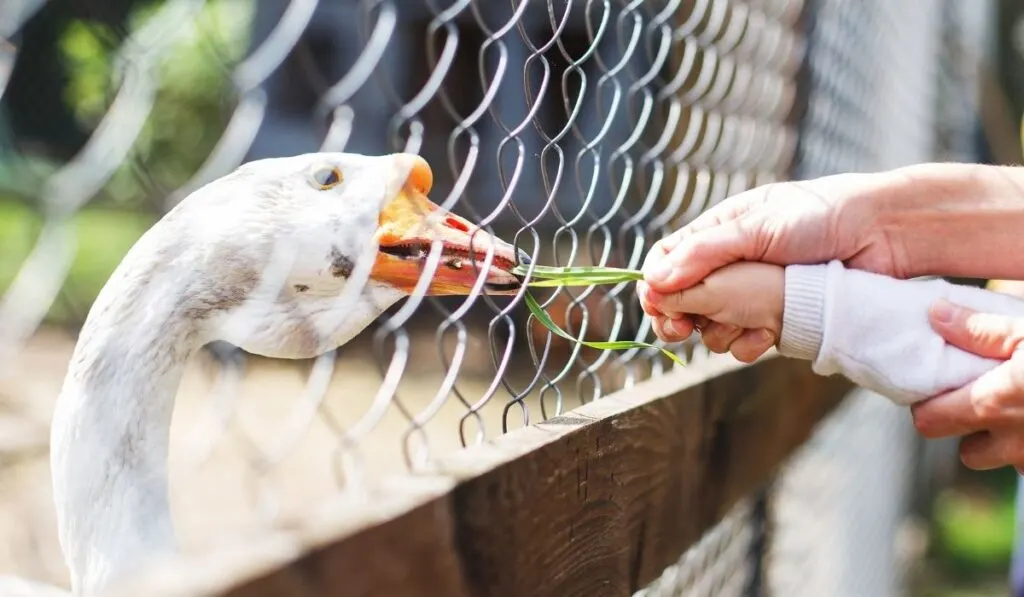
Feeding Habits and Nutrient Requirements
Goose diets may vary depending on their growth stage. Adult geese have a different diet than goslings. This is because younger birds generally need more protein in their feed. During their first six weeks, you can feed goslings with starter feed that contains around 22 percent protein.
Some commercial starter feed might contain coccidiostats that can cause lameness or death in goslings. So, be sure to monitor for any signs of these antiprotozoal agents when buying their feed.
On the other hand, adult geese are excellent grazers and they generally prefer to forage. If you can’t provide them with a lot of grass, high-quality hay and fresh vegetables can be included in their diet.
You can also add grains and high-quality poultry pellets into their feed. Oats, wheat, and organic corn are some of the nutritious grains that can supplement geese with different vitamins that are vital for their growth.
If you raise geese on the range, feeding them with high-quality pasture should be your main focus. Almost any grasses or forages can be fed to geese except for plants that they don’t prefer such as alfalfa. Ideally, you should keep the grasses fresh, young, and less than 4 inches high.
When foraging, geese will also eat bugs, snails, slugs, worms, and other small creatures that could provide them with enough protein for their growth.
The amount of pasture that you should provide will depend on the type of geese and their ages. Generally, an acre of pasture can accommodate around 20 to 40 geese.
Finally, you should also cover their grazing area with fences to protect these birds from escaping or being attacked by predators. A 3-foot tall wire fence, electric fencing, or even fox-proof fencing is more than enough to keep them safe.
Slaughtering Geese for Meat
When it comes to slaughtering geese, the process is similar to butchering other poultry birds. They are suspended upside down, with their heads placed inside a killing funnel before the jugular veins on the left side of their neck are cut with a sharp knife.
The funnel acts as a restrainer to prevent these birds from flapping their wings. During the bleeding process, you can place a metal blood cup to prevent the blood from dripping on the floor.
Once the blood has completely stopped flowing out of their neck, you can manually pluck their feathers. This process might be difficult and time-consuming but it will increase the quality of the carcass.
Alternatively, you can also scald the carcass by dipping it in a hot water at a temperature of 140-154° F for one to three minutes to loosen the feathers.
Generally, large wing and tail feathers can be manually plucked by hand but the down and pin feathers will be removed with a wax dip.
A wax dip requires the carcass to be dipped in a wax bath for one or two minutes. Then, the carcass will be dipped in cold water to harden the wax before being again in the wax for the second time to create the second layer. Finally, after the second layer has been hardened with a cold water dip, the wax layers will be stripped using hands or a dewaxing machine.
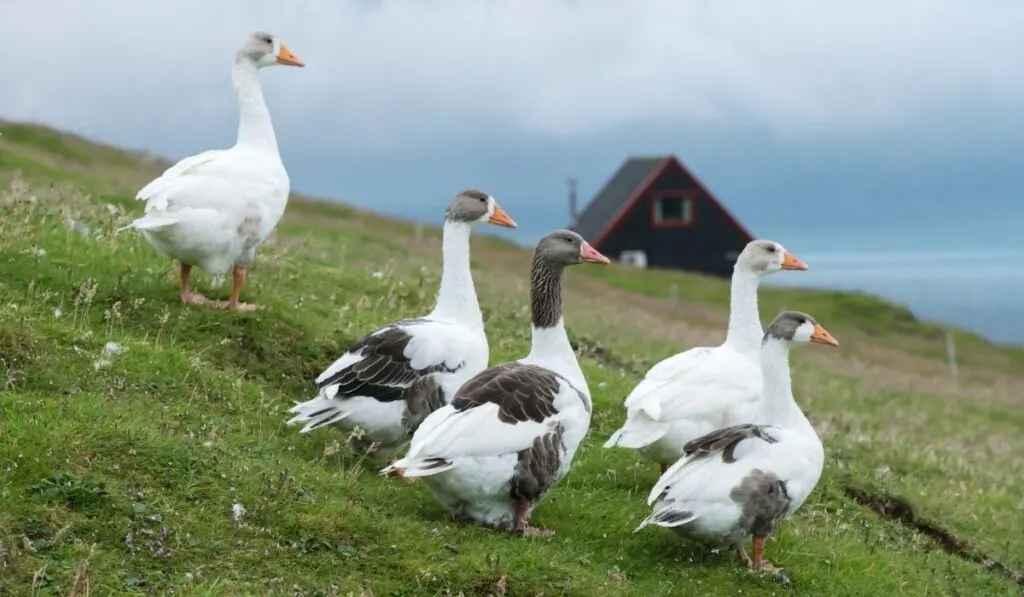
Geese Diseases and Health Management
Geese are extremely hardy and resistant to many diseases. However, unfortunate events could occur from time to time and they might contract illnesses that could turn critical if they are left untreated. These are some of the most common diseases that can affect geese:
- Aspergillosis
- Avian Adenovirus
- Botulism
- Chlamydiosis
- Coccidiosis
- Cryptosporidiosis
- Derzy’s Disease
- Duck Virus Enteritis
- Erysipelas
- Flukes
- Fowl Cholera
- Leucocytozoonosis
- Listeriosis
- Mycosis of digestive tract
- Mycoplasma Infections
- Mycotoxicoses
- Nectrotic Enteritis
- Nematodes
- Newcastle Disease
- Parathyphoid
- Spirochaetosis
- Sinusitis
- Staphylococcocis
- Streptococcocis
- Tapeworms
- Trichomoniasis
- Venereal Diseases

Most of the diseases listed above can be controlled by taking preventive measures to ensure that sick birds are isolated and won’t infect the whole flock. However, you can also reduce the possibility of having to deal with these problems by taking these steps:
- Always purchase your geese from certified, reputable breeders and make a thorough check before bringing the birds back home.
- Avoid adding or mixing your geese with the birds outside of the flock.
- Schedule a regular cleaning routine of the feeders and waterers.
- Don’t mix younger geese with the older ones. This is because the younger they are, the more susceptible they are to be infected with diseases.
- Bring geese for vaccinations and medical inspection whenever you see any signs of sickness.
- Provide a clean and stress-free environment for your geese.
- Don’t allow visitors to visit your farm or backyard without any protective clothing. If they have been to other farms in the last 14 days, then, it is best for you to not let them get close to your geese.
- Be vigilant and monitor for any signs of sickness inside the flock. Then, isolate the sick birds immediately and away from the others.
- Schedule a thorough cleaning and disinfecting routine of their housing and equipment.
- If you intend to sell your geese, do not allow buyers to bring dirty or unsanitized crates and boxes onto your farm. It is better for you to provide them with your own clean containers.
- Rotate the pasture and treat the soil with 5 to 6g of ferric sulfate per square meter.
- Schedule regular deworming every three or six weeks whenever you notice that the birds have been living deep in their litter. Examine their droppings for worms or oocysts at least once a month.
- Destroy or incinerate dead geese quickly after their death. This is to avoid any infection that could happen from leaving their carcasses around healthy geese.
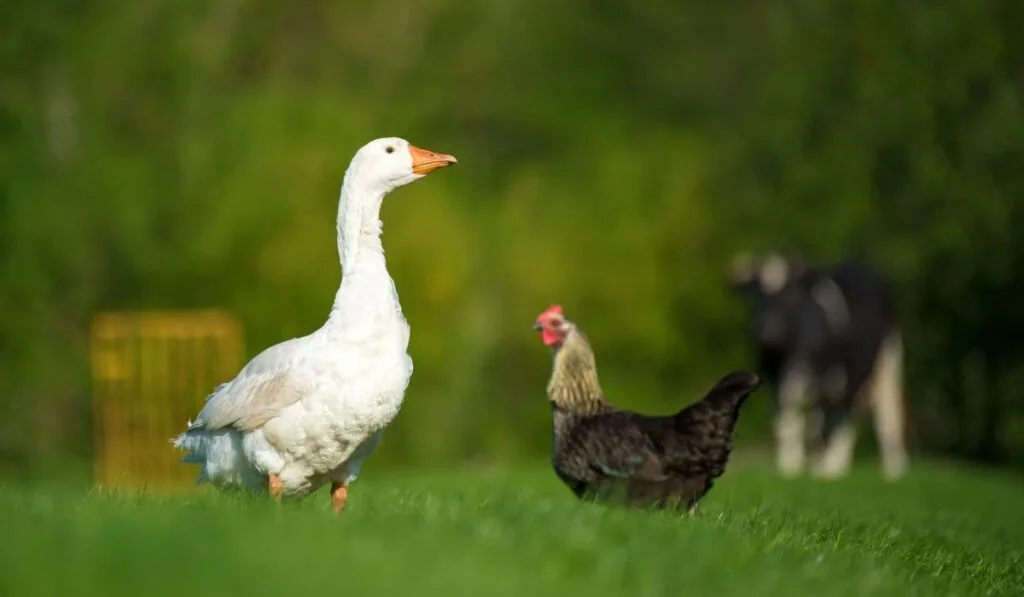
Raising Geese With Other Animals
You can definitely keep geese with other birds such as chickens and ducks if there is enough space and forages for these animals. However, geese are slightly larger than chickens and you should always watch for any signs of aggression to avoid fights that can potentially hurt either bird.
But if you raise these birds and mix them with each other when they are still young, they can bond and mingle with each other for a very long time.
Avoid keeping geese with ruminants such as goats and cows. This is because these animals will consume geese feed and contaminate their feeders or waterers, which in turn can lead to poor hygiene and other sanitation issues.
Final Thoughts
Above all, raising geese in your backyard or farm is absolutely rewarding, both from the financial and emotional standpoint. Geese are easy to keep, self-sufficient, and nurturing toward their goslings. Raising these birds from a very young age will create an unbreakable bond that’s almost similar to raising house pets such as dogs and cats. This reason alone is more than enough to motivate you in raising your own geese!
Citations
- https://www.motherearthnews.com/homesteading-and-livestock/raising-ducks-geese/goose-breeds-zm0z14fmzchr
- https://poultry.extension.org/articles/getting-started-with-small-and-backyard-poultry/selecting-birds-to-get-for-a-small-or-backyard-poultry-flock/selecting-a-goose-breed-for-small-or-backyard-poultry-flocks/
- https://www.therusticelk.com/raising-geese-on-the-homestead/
- https://practicalselfreliance.com/getting-started-with-geese/
- https://poultry.extension.org/articles/poultry-management/raising-geese-in-small-or-backyard-flocks/
- https://www.mofga.org/resources/poultry/raising-geese/
- https://www.timbercreekfarmer.com/raise-healthy-geese-backyard-farm/
- https://www.fao.org/3/y4359e/y4359e0g.htm
- https://opensanctuary.org/article/building-a-good-home-for-geese/
- https://www.chickens.allotment-garden.org/keeping-geese/housing-geese-pasture-safety/
